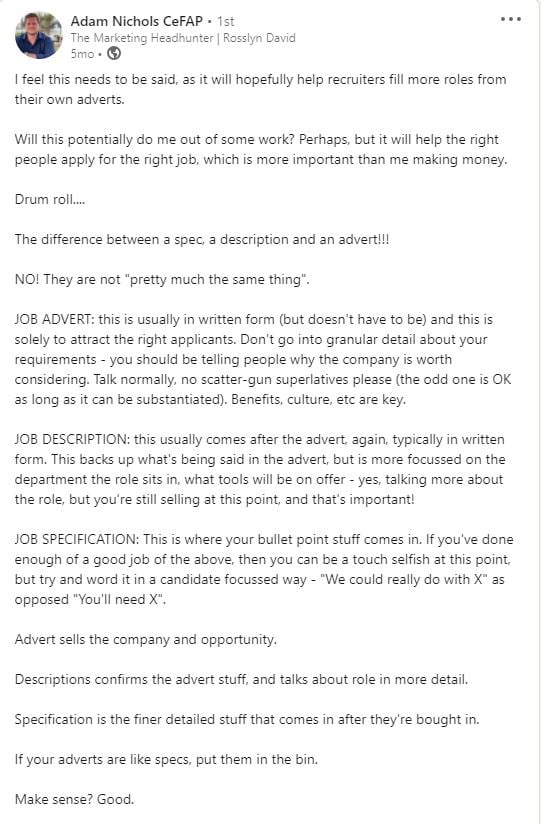Attraction / Talking Brand: 7 quick wins to enhance your candidate experience

William Geldart
November 30, 2021
Candidate experience can be a loaded and highly emotive term at the best of times. Throw in the whole employer brand milieu, ‘The Great Resignation’, personalisation, and all manner of other line items, and it can be hard to calibrate around what we actually mean when we talk about it.
Why is it all so messy and complicated?
(clue: it doesn’t have to be). The following items are designed as quick wins to enhance your candidate experience. It’s belt and braces stuff and not an exhaustive list. Candidate workflow journeys, labyrinthine automations and a Bible of content ideas can wait for another day.
This list is for those of you looking for inspiration in the here and now.
Let’s dive in.
1. Tell people what’s changed
Openness and authenticity are often cited as two essentials when it comes to showcasing what it's like to work for an organisation. Rightly so, but how does this translate in practical terms?
One proactive step you can take is to address the (negative) experiences of employees past and present.
Responding to employee reviews on sites such as Glassdoor should be a given.
And if your company has taken steps to address problem areas then you should be telling people what's changed. Use your right to reply across review sites, your blog, socials, candidate nurture emails, whichever medium you feel is appropriate. But be specific - and never smug.
E.g - "We've acknowledged the frustration you've voiced around a lack of praise and recognition and understand that we must do better. To act on this, we've created steering groups to capture regular feedback, provided more guidance and training to line managers, and we've incorporated questions around praise and recognition into our wider engagement framework. As a result, our engagement score on this metric has improved by x in y period of time. And through monthly pulse checks and quarterly engagement surveys we'll continue to closely monitor this key area."
2. Create Candidate FAQs
This is 'Employer Brand 101'. What are the typical questions that candidates ask about your business, or specific roles? Make a note of them and the answers you frequently provide around working hours, flexible working arrangements, team structure, compensation and benefits, progression pathways, KPIs, managerial expectations etc.
You can turn this into content for your candidate packs, infographics, slideshares or short videos from hiring managers. There's a bountiful list of applicable use cases and none of them are cost or time prohibitive.
And you'll probably find that the answers you think of trigger separate conversations around comp and bens packages, promotion criteria and other key areas that you might need to re-visit.
3. Record and share your briefing conversations
From a candidate's perspective, who better to get the lowdown from then their potential future boss?
Recording and sharing conversations between your recruiters and hiring managers is an easy win (we're all using Teams, Zoom or Hangouts?!) and provides the candidate with essential information straight from the horse's mouth.
An 'organic' (as can be) conversation will also give candidates a feel for your company culture and gives recruiters great ammo for their outreach.
4. Get testimonials from returnees
There's tons of reasons why a 'Boomerang' employee will want to rejoin your company and why you should welcome them back with open arms.
Provided you're happy with re-hiring them, make sure to bottle that feeling.
Your returnees have unique insight to offer. Their well-rounded perspectives enable them to articulate both sides of the employee experience - the good and the bad.
Capture the 'how' and the 'why' around their decision to come back, and what makes this relevant to your audience.
5. Craft job adverts, not job descriptions
This post from top headhunter, Adam Nichols, pretty much sums it up when it comes to the demarcation between what constitutes a job advert and what doesn't.
Your job adverts (typically social posts) should be a short summary that explains why a candidate should consider your company and the role. It should NOT contain 25 bullet points explaining every single responsibility and requirement - save that for the spec.
Feel free to attract and repel in equal measure in order to hone in on the right candidates. But don't go overboard on superlatives. You'll be justifiably derided if you're at pains to shout about a "super exciting rapid-growth journey fuelled by VC investment as part of a market-leading digital transformation programme."
Do mention salary and key benefits. And remember that your job advert isn't all about you, it should focus on appealing to the people you wish to hire.

6. Ditch the traditional buyer (candidate) persona
Every so often a piece of marketing gold will land in my inbox and make the tiny hairs on my neck stand on end. One particular edition of the 'Everyone Hates Marketers' newsletter had such an effect. It focussed on the rights and wrongs of building buyer personas and I'm going to apply some of the thinking to their candidate-focussed cousin.
Candidate personas have been around a while. I've used them myself and preached about their worthiness as a recruitment tool. Perceived wisdom goes that they can help you build-up a picture of your ideal hires and create consistency in the hiring process.
But, as is always the case in marketing, sometimes you've got to challenge your preconceptions and rethink your own script.
Fundamentally, building a dating profile-style persona that only covers baseline demographics won't help you understand why people would want to join your company.
In the worst case scenario, this approach is reliant on pure guesswork. Because what channels someone hangs out in, how many children someone has and what media they consume has little to do with their motivations for switching employers.
In productland, marketing guru Seth Godin has laid out three psychographics that matter:
- Triggers: What made your customers say, "I want to make progress in my life"? Why now?
- Pains: What constraints or pains are stopping them from making progress?
- Goals: What progress do they want to make in their life? What functional, social, or emotional goals do they want to reach?
Change up some of the wording and nuance and you can apply similar rationale to evaluating candidate behaviour. What triggers do your candidates have? What progress do they want to make? What's stopping them and how can your role remove these blockers and help them reach their goals?
The newsletter then goes on to explore the six steps to creating a useful persona. You NEED to check these out and start actioning. Begin by asking your most recent hires what triggered them to make a change and join your business.
7. Give specific feedback to rejected candidates
Incorporating feedback loops into your candidate experience is no longer a 'nice-to-have'.
Through simple surveying tools you can create touchpoints for different parts of the hiring process (initial call, first interview, final interview, offer/rejection, three months into the role etc) and create scoring systems that capture thoughts and sentiment.
And when it comes to providing rejected candidates with specific feedback, the guys at Gem have put together a useful guide and candidate scorecard.
Granted, it might not be possible to respond to every job application with specific notes.
However, if you're phone screening or interviewing, there are certain best practices you should adopt to acknowledge the time and effort put in. It'll help your candidates, it'll enhance your candidate experience (and talent brand) and strengthen your end-to-end hiring process.
Ultimately, by being tactful, timely and specific you'll build trust and credibility. Check out the Gem insights in more depth.
So, how are you going to enhance your candidate experience? I'd love to hear your thoughts and I'll be sharing plenty more of mine over on LinkedIn if you'd like to follow me or connect.


